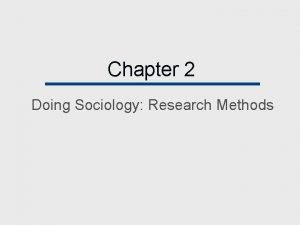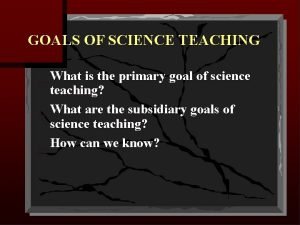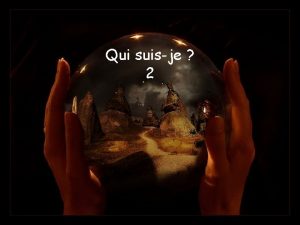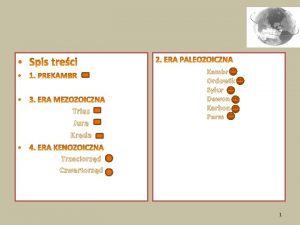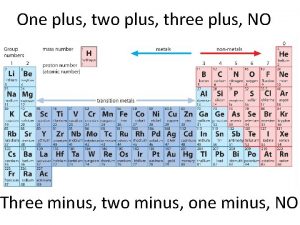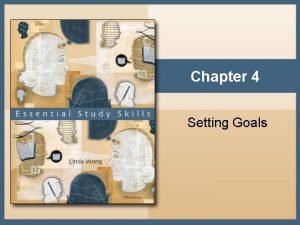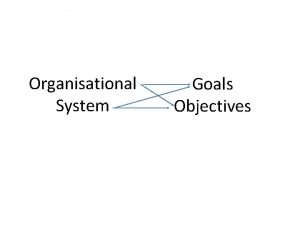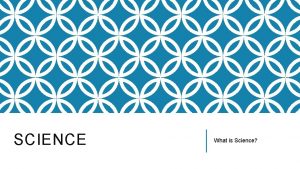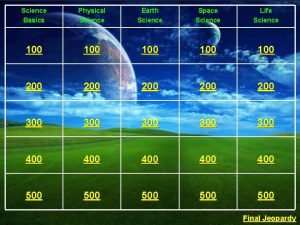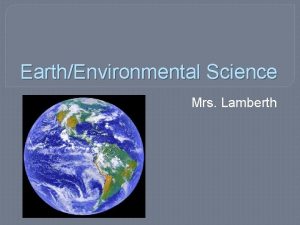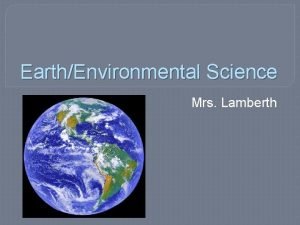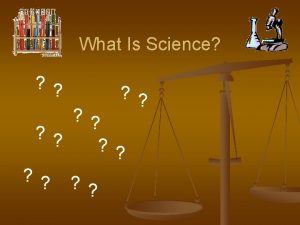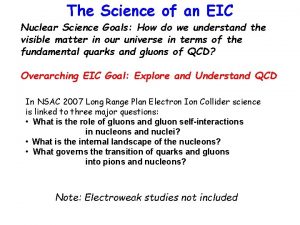Outline Science Goals of PK3 Plus PK3 Plus




















- Slides: 20


Outline • Science Goals of PK-3 Plus • PK-3 Plus experimental setup • Results: ◦ Electrorheological plasmas – string fluid formation ◦ Two phase flow – lane formation ◦ 3 D phase transition crystal – liquid • Conclusion

PK-3 Plus Science Goals • Ordered structures in 3 D complex plasma in a weak electric field • Crystal-liquid-gas phase transitions in 3 D isotropic complex plasma system • Structural phase transitions in 3 D complex plasma under external actions • Linear and nonlinear waves in 3 D complex plasma including shock waves, instabilities • Transport of microparticles • Boundaries in complex plasmas • Decharging

The Plasma Chamber • High homogeneity of plasma parameters due to electrodes design • Perfect observation conditions due to glass walls • High homogeneity of temperature due to construction design 2 D 3 D • 13. 56 Mhz RF power driven large disk electrodes • Wide ground rings around the electrodes • Guard rings hold 3 dispensers each • The dispensers provide 14. 91; 9. 19; 6. 81; 3. 42; 2. 55 m melamine formaldehyde and 1. 55 m silica mono disperse particles

PK-3 Plus hardware • turbomolecular pump inside the container provides HV conditions in the 10 -6 mbar range • continuous gas flow for stable high purity gas conditions • pressure control – baratron, piezo, pirani • 2 gas reservoirs filled with Ar and Ne • RF control – voltage, current (measured on electrodes) • function generator 0 – 255 Hz, -55 V – +55 drives electrodes independently with sinusoidal, square, triangle etc. shapes • • 4 progressive scan cameras (up to 50 Hz frame rate) horizontal translation stage vertical translation stage digital storage of 4 analogue video signals on hard disks

Laboratory Onboard Accommodation • experiment hardware enveloped in safety housing and connected to outside prevacuum port at transfer compartment • telescience unit includes ruggedized laptop and 4 digital video recorders • LCD video monitor allows control by operator PK-3 Plus, Yu. Malenchenko (2008)

Electrorheological plasma • At zero field particles + interact via classic + - + Debye-Hückel potential + ion drift + • Ion drift generates the positive ion wake Morfill & Thomas, JVST 1996 Hayashi & Tachibana JVST 1996 Schweigert et al PRE 1996 Lipaev et al, JETP, 1997 + ion drift + • The ac field Eext with frequency f: fdust << fion causes ions react PK-3 Plus, Th. Reiter (2006) instantaneously but grains do not react • Field-induced interactions in complex plasmas are identical to interactions in conventional ER fluids with dipoles d = 0. 65 Qλvion/vth (Ivlev A. V. et al. PRL 100, 095003, 2008) • We can manipulate interparticle interaction via ion velocity vion by electric field

Kinetics of strings formation Time of string fluid recreation is about 15 seconds PK-3 Plus, F. Yurchihin (2006)

Two phase flow Dispensers test : 14. 9, 9. 2, 6. 8, 3. 4, 2. 5, 1. 5 µm particles diameter PK-3 Plus, V. Tokarev (2006)

Colloids – Lane Formation • Strongly interacting colloidal mixture consisting of oppositely driven particles Ø Nonequilibrium transition towards lane formation (Rayleigh-Taylor instability) • Lane formation is a generic process and occurs: • • Colloidal suspensions Ions migrating within 2 D membranes Pedestrian zones Complex plasmas force J. Chakrabarti et al. , PHYSICAL REVIEW E 70, 012401 (2004)

Quasi continuous flow PK-3 Plus, Yu. Malenchenko (2007)

Reentrance effect in complex plasma lanes • lane formation experiments were made at different conditions • increasing interaction potential prevents lane formation J. Chakrabarti et al. , PHYSICAL REVIEW E 70, 012401 (2004)

Penetration of 1. 55μm particles through 2. 55μm particles cloud

Crystal-Liquid Phase Transition • The plasma crystal in ground lab melts while pressure decreases • The plasma crystal in space lab melts while pressure increases P=13. 6 Pa (pressure decreases) P=11. 3 Pa (pressure minimum) P=14. 7 Pa (pressure increases) P=20. 9 Pa (pressure maximum) PK-3 Plus, Yu. Malenchenko (2007)

Without external field Pair distribution function g(r) Crystal 1. 55 μm grains Argon pressure 11. 7 Pa Frame size 8136 x 5932. 8 μm Dependences of K and pressure on time Liquid 1. 55 μm grains Argon pressure 21. 1 Pa Frame size 8136 x 5932. 8 μm K=g(rmin)/g(rmax) =0. 2 - crystallization point Frenkel & Mc. Tague Ann. Rev. Phys. Chem. 1980

Phase diagram

Phase transition search for 2. 55μm particles cloud

With low frequency external field (255 Hz) Pair distribution function g(r) Crystal 1. 55 μm grains Argon pressure 11. 3 Pa Frame size 8136 x 5932. 8 μm Dependences of K and pressure on time Liquid 1. 55 μm grains Argon pressure 21 Pa Frame size 8136 x 5932. 8 μm K= 0. 2 - crystallization point Frenkel & Mc. Tague Ann. Rev. Phys. Chem. 1980

Conclusions • The experiments with PK-3 Plus show the perfect functioning of the apparatus • Structural phase transition was discovered • Lane formation was investigated at different complex plasma parameters • Crystal-liquid phase transition was obtained in large 3 D isotropic complex plasma system • PK-3 Plus provides much better insights into the properties of complex plasmas

MPE and IHED scientific teams are very much appreciated to all specialists from DLR, Roscosmos, RSCE “Energia”, Gagarin Cosmonaut Training Centre, Moscow Mission Control Centre, Kayser -Threde who made possible “Plasma Crystal” experiments. Very special thanks to cosmonauts who made the decisive steps in the experiments realization from January 1998 1. 2. 3. 4. 5. 6. 7. 8. 9. 10. 11. 12. 13. 14. Vinogradov P. V. Soloviev A. Ya. Budarin N. M. Musabaev T. A. Baturin Yu. M. Avdeev S. V. Padalka G. I. Kalery A. Yu. Zaletin S. V. Krikalev S. K. Gidzenko Yu. P. Shepherd W. Usachev Yu. I. Tyurin M. V. PK-1, PK-3 Plus PK-1, PK-3 twice PK-1, PK-3 PK-2, PK-3 PK-2 PK-3 twice PK-3, PK-3 Plus 15. 16. 17. 18. 19. 20. 21. 22. 23. 24. 25. 26. 27. 28. Dezhurov V. N. Onufrienko Yu. I. Kozeev K. M. Haignere C. Tretschev S. E. Korzun V. G. Malenchenko Yu. I. Sharipov S. Sh. Tokarev V. I. Reiter T. Yurchichin F. N. Kotov O. V. Volkov S. A. Kononenko O. V. PK-3 PK-3, PK-3 Plus twice PK-3 Plus PK-3 Plus
 Strategic goals tactical goals operational goals
Strategic goals tactical goals operational goals Strategic goals tactical goals operational goals
Strategic goals tactical goals operational goals Eric’s favourite .......... is science
Eric’s favourite .......... is science General goals and specific goals
General goals and specific goals Motivation in consumer behaviour
Motivation in consumer behaviour Labeling theory of deviance examples
Labeling theory of deviance examples Advantages and disadvantages of sociology
Advantages and disadvantages of sociology What is sentence outline
What is sentence outline Goals of science teaching
Goals of science teaching Measurement and scientific tools lesson 2 answer key
Measurement and scientific tools lesson 2 answer key An animated introduction to social science
An animated introduction to social science Plus haut plus loin que l'azur infini
Plus haut plus loin que l'azur infini Je contiens du sucre sans être sucré. que suis-je
Je contiens du sucre sans être sucré. que suis-je Kreda, jura i trias
Kreda, jura i trias Plus j'apprends plus je me rends compte de mon ignorance
Plus j'apprends plus je me rends compte de mon ignorance Natural vs social science
Natural vs social science Branches of science diagram
Branches of science diagram Natural and physical science
Natural and physical science Applied science vs pure science
Applied science vs pure science Rapid change
Rapid change Science fusion think central
Science fusion think central






